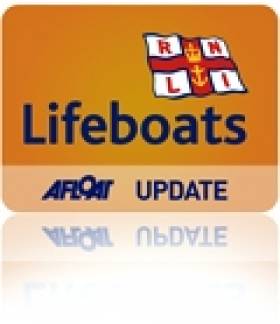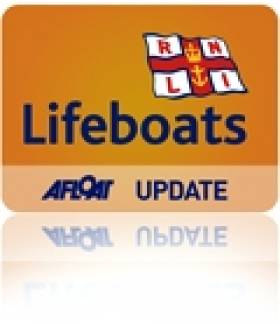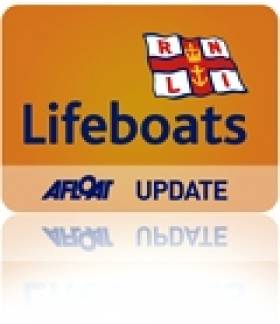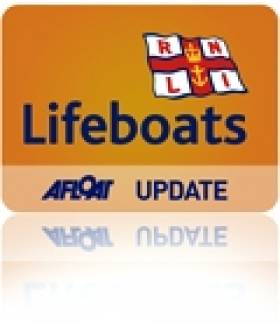Displaying items by tag: Lifeboats
Skerries Lifeboat Tows Five To Safety
#RNLI - Skerries RNLI towed a group of four adults and one child safely to shore after their motorboat developed engine difficulties.
Skerries RNLI volunteer crew launched their Atlantic 85 lifeboat Louis Simson shortly after 4.30pm yesterday afternoon (Monday 1 September) following reports to Dublin Coast Guard of a motorboat adrift near the Perch marker off Skerries.
The crew could see the casualty vessel almost immediately after exiting the launching trolley and proceeded directly to them.
Once alongside, it was discovered that the outboard engine would not start. A tow was established and the boat was returned safely to shore.
At the time of the launch there was a Force 1 easterly wind with calm seas.
Speaking after the callout, volunteer lifeboat press officer Gerry Canning said: "This was a good result – most importantly, everybody on board was wearing a lifejacket and the alarm was raised quickly."
Join In The Fun At Howth Lifeboat Open Day This Sunday
#RNLI - For a free, fun, family day out, look no further than Howth this Sunday 31 August for the annual Open Day at Howth RNLI.
Between 2pm and 5pm the public can meet the volunteer crew, see the lifeboats and try some of the local food, drink and activities that prove Howth Is Magic.
Last year's event was hailed as a great success and all at the lifeboat station are expecting the same for this year. For more see the Howth Lifeboat Open Day event page on Facebook HERE.
Clogherhead Lifeboat Crewman Rescues Two After Fishing Boat Sinks
#RNLI - A lifeboat crewmember from Clogherhead RNLI has been praised for his swift actions in rescuing two men from a fishing vessel that sank at the weekend.
Sean Flanagan and his son were fishing approximately two miles away from Port Oriel in Co Louth on Saturday 23 August when they noticed a Razor fishing boat sink a mile in the distance shortly before 5.30pm.
Flanagan, a highly trained volunteer crewmember, raised the alarm and made a Mayday call. He quickly hauled his gear and made best speed to the scene where he found two men in the water alongside their sunken boat.
Together with his son, Flanagan successfully pulled the men out of the water and into the safety of his vessel.
Meanwhile, Clogherhead RNLI’s all-weather lifeboat under coxswain Tomas Whelan and with four crewmembers on board had launched and made its way to the scene. The Dublin-based Irish Coast Guard helicopter Rescue 116 was also tasked.
Weather conditions at the time were described as good with clear visibility and a calm sea state.
The casualties were transferred to the lifeboat on arrival where they were medically assessed by lifeboat crew. They were then airlifted by helicopter to Our Lady of Lourdes Hospital in Drogheda.
Speaking following the callout, Whelan said: "We have to commend the swift actions of our lifeboat crew member Sean Flanagan who not only made the Mayday call for the emergency services but then rapidly went to the scene and rescued the two men from the sea."
#RNLI - Howth RNLI had a busy start to the weekend, towing two motorboats to safety in separate incidents between Friday night and Saturday morning.
Pagers sounded at 7.15pm on Friday evening (22 August) with a launch request for the inshore lifeboat to locate and assist a motorboat drifting without power in the vicinity of Howth Sound. The motorboat with two people aboard was quickly located and towed to Howth Harbour.
The following morning (Saturday 23 August) pagers alerted again at 11.05am for the inshore lifeboat to locate a motorboat adrift off the nose of Howth. The motorboat with two crewmembers aboard was taken in tow to Howth Harbour.
"On both occasions the crewmembers were able to make radio contact with the shore, supply an accurate description of the vessels and their location which allow us to locate and offer assistance in the quickest possible time," said Howth RNLI helm David Howard.
"We were pleased to see that all crew members on both occasions were wearing lifejackets."
Howth's volunteer crews have one of their busiest seasons yet, with 50 callouts so far.
Galway Lifeboat Rescues Three From Vessel Adrift Off Barna
#RNLI - Galway RNLI came to the rescue of two men and a child whose boat got into difficulty off Barna Pier in Galway Bay yesterday afternoon (Friday 22 August).
The 18ft bayliner was about half a mile off Barna when its engine failed. The boat drifted for some 30 minutes before the men on board called 999, at about 2.20pm.
The Irish Coast Guard sought the assistance of the Galway lifeboat, which launched from the city docks 10 minutes later.
The lifeboat crew of helm Kieran Tolan, David Badger, Olivia Bryne and Dara Oliver quickly arrived on scene and took the vessel in tow back to Barna. None of the people on board required medical attention.
Speaking after the callout, Tolan said: "Conditions were calm, with an offshore breeze, and although at the time they were in no immediate danger, they did the right thing in calling the lifeboat as situations on the water can change very quickly into more serious incidents."
#RNLI - Rosslare RNLI was called out twice yesterday afternoon (Friday 22 August) to help two separate boats with ropes wrapped around their propellers.
In the space of two hours, both boats – a RIB with two people on board off Carna Pier and a motor cruiser with two on board near Waterford Harbour – were freed by the volunteer lifeboat crew.
The double callout also came on the last day for retiring lifeboat operations manager Michael Doyle.
"Two callouts in one afternoon is a fitting way to say goodbye," said Rosslare RNLI volunteer lifeboat press officer Jamie Ryan.
"Thankfully both call outs were to vessels that had their propellers fouled and no lives were in danger. The lifeboat is there to help anyone in trouble at sea and we were happy to provide assistance in these two cases."
Elsewhere on the east coast, Wicklow RNLI's all-weather lifeboat launched at 4am yesterday morning to the aid a yacht in difficulty eight miles north of Wicklow Harbour.
The yacht was on passage to Greystones when the propeller became fouled in ropes and was unable to make any headway.
"We located the yacht with four people one mile south-east of Greystones Harbour," said coxswain Nick Keogh. "Two lifeboat crew were transferred onto the yacht to assess the situation and they managed to clear the rope obstructing the propeller.
"With the propeller free the yacht was able to make her way into Greystones under its own power."
Crosshaven Lifeboat Joins Major Search For Missing Speedboat
#RNLI - A major rescue operation swung into action early this morning after reports of a speedboat crashing into a channel marker buoy in Cork Harbour en route from Cork city to Crosshaven.
Crosshaven's volunteer lifeboat crew were paged at 45 minutes past midnight to the incident in the lower part of Lough Mahon after the report of a boat with one person on board believed missing after the collision with a navigation buoy.
The area was extensively searched by Crosshaven RNLI along with the Crosshaven Coast Guard boat, the pilot launch Fáilte, Irish Coast Guard helicopter Rescue 117 and coastguard shore teams.
The casualty boat along with its slightly injured owner were eventually located at a marina in Crosshaven. All teams were stood down shortly before 3.30am this morning.
Crosshaven's lifeboat crew on this service were helm Ian Venner, Vince Fleming and Kieran Coniry.
Naming Ceremony For Helvick Head RNLI's New Lifeboat Next Saturday
#RNLI - The naming ceremony and service of dedication of Helvick Head RNLI’s new Atlantic 85 lifeboat Robert Armstrong will take place at the lifeboat station on Helvick Pier on the south side of Dungarvan Bay at 11am on Saturday 30 August.
The new lifeboat was funded through a legacy from the late Robert Armstrong and will be named in his memory. Robert passed away on 9 November 2009 and the lifeboat will be named by his niece Judi Fleming during the ceremony.
Robert Armstrong was born in 1936 and loved sailing, fishing and boats. He crewed in the English Channel and the North Sea. Bob’s main home was Blackheath but he was most relaxed at his holiday home in Potter Heigham on the Norfolk Broads, where he moored his own boat.
Commenting ahead of the ceremony, his niece Judi said: "Robert’s aunt Alice and her brother Charles were the donors of Alice and Charles, Helvick Head RNLI’s previous lifeboat. Robert attended the ceremony back in 2000 and he was given an RNLI jacket which he wore proudly.
"It is great that something is left in his name of such importance as a lifeboat; saving people’s lives. We as a family are very proud of Bob and what he has done. He would have been 78 on 31 August."
Several members of the Armstrong family will travel from the UK to attend the naming ceremony and service of dedication.
The new lifeboat is an Atlantic 85, built at a cost of €255,000, and has a number of improvements from the Atlantic 75, Helvick Head’s former lifeboat, including a faster top speed of 35 knots, radar, provision for a fourth crewmember and more space for survivors.
It can operate safely in daylight in up to Force 7 conditions and at night up to Force 6. It also allows lifeboat crews to respond even faster in emergencies.
Helvick Head RNLI fundraising chairman Oliver Clancy will MC the ceremony and Chaplin Fr Conor Kelly and the Very Rev Dean Draper will lead the service of dedication.
Lifeboat operations manager Ian Walsh will accept the lifeboat on behalf of Helvick Head lifeboat station.
Local dignitaries, guests and RNLI volunteers from other lifeboat stations on the coast and the general public will also be in attendance. Cór Fear na nDéise, the local men’s choir and Pax, Cárthach and Macdara Ó Faoláin will perform at the event in addition to Dónal Clancy, who will sing the RNLI anthem 'Home from The Sea', which was sung by his dad the late Liam Clancy as the Alice & Charles was launched in 2000.
All are welcome to attend this event, but are asked to park their cars on the main road, as access to Helvick Pier from the Erin’s Hope monument will be controlled in the interest of public safety. There will be extra parking in Murray’s field near the pub on the main road in Helvick.
Following the ceremony and with conditions permitting, the Robert Armstrong lifeboat will be launched.
Arklow Lifeboat Tows Local Fishing Vessel To Safety
#RNLI - Arklow RNLI’s volunteers were alerted by pager at 9.22am yesterday morning (Wednesday 20 August) and launched the lifeboat Ger Tigchleaar within minutes to a call for help from a local fishing vessel with engine problems.
In a moderate sea, the lifeboat crew – coxswain Ned Dillon, mechanic Michael Fitzgerald, Roger Tyrell, John Bermingham, Andy O'Loughlin and Jimmy Myler – proceeded to scene.
After locating the casualty vessel 11 miles south southeast of Courtown, the RNLI crew established a tow line and proceeded with the long slow tow back to Arklow, arriving at 11.30am.
The two crewmembers aboard the casualty vessel remained aboard during the tow home and all hands came ashore safely at Arklow.
Speaking following the incident, volunteer lifeboat press officer and sea safety officer Mark Corcoran said: “All persons who take to the water, whether for a living or for pleasure, must always wear their lifejackets and should always have a means of raising the alarm.
"Even with the years of experience these professional fishermen have, mechanical problems can still occur. Please don’t take chances when going to sea.”
Man Rescued Sailing To America In Flimsy Dinghy
#Rescue - Lifeboat volunteers on the Dorset coast went to the rescue of a man attempting to sail to America in a 14ft dinghy, as NewsTalk.ie reports.
Mudeford RNLI were launched after reports from a passing yacht that had concerns about the solo offshore boater.
On arrival, the lifeboat crew found the Bulgarian national on the dinghy was "exceedingly cold, wet and violently ill" yet was refusing their assistance.
They soon ascertained that the 30-year-old man, who has a US visa, had bought the dinghy earlier that day, packed it with some meagre supplies – without any suitable safety equipment or navigation aids – and set out to cross the Atlantic.
"He would have died [if we left him there," said lifeboat crewman Pete Dadds. "He was severely sea sick, he had the first signs of hypothermia and his boat was filling up with water."
NewsTalk.ie has more on the story HERE.






































































